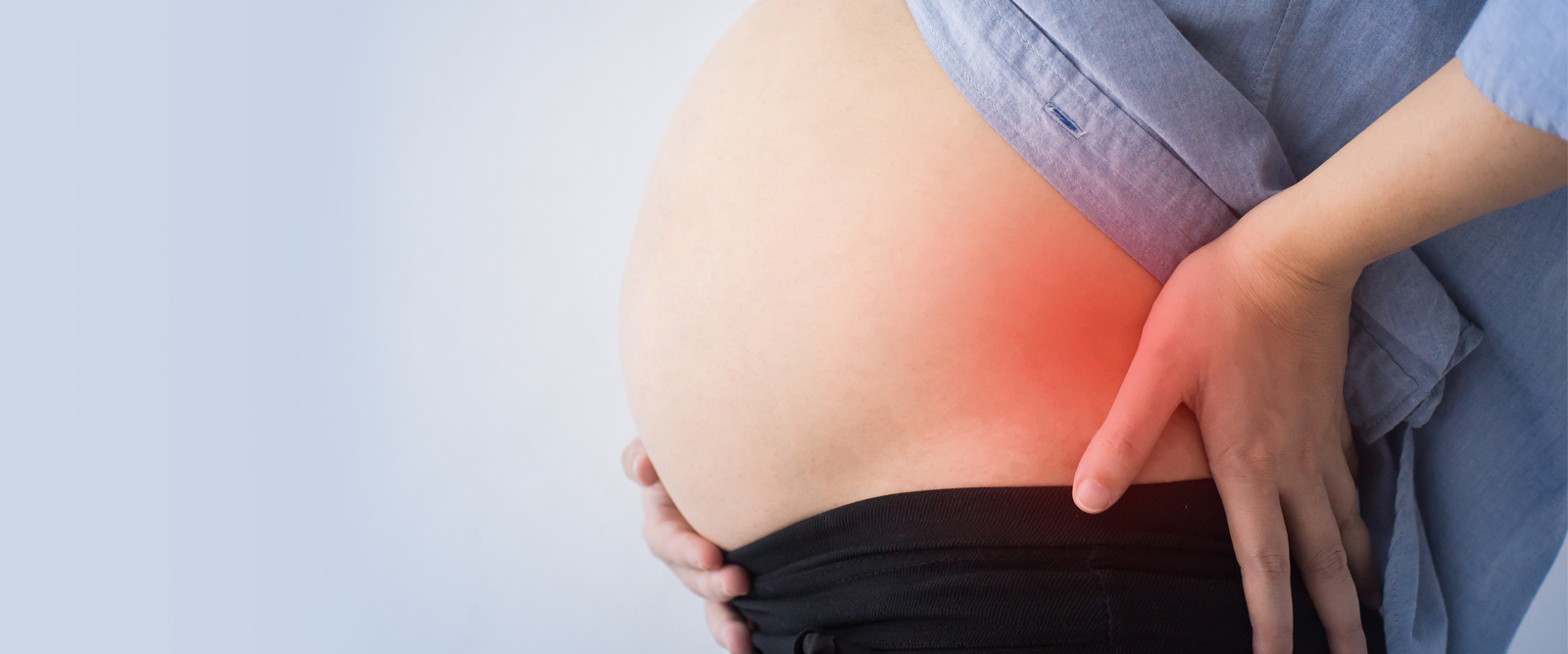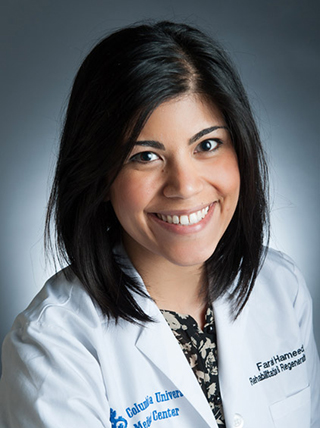Dealing With Pregnancy-Related Back Pain? These Tips Will Help
Back pain occurs in half of pregnancies. Here’s how to manage your discomfort.

As joyful as expecting a child can be, pregnancy also brings stress and strain on the body. That often means back pain.
“One in two patients will have some amount of back pain during pregnancy,” says Dr. Farah Hameed, a pregnancy-related back pain specialist with NewYork-Presbyterian Och Spine. “And one in four will experience back pain following childbirth.”
The risk for pregnancy-related back pain increases with a person’s age and the number of previous births, especially in those with a history of back pain in a prior pregnancy, says Dr. Hameed, who is also an assistant attending physician at NewYork-Presbyterian/Columbia University Irving Medical Center. Carrying multiples, bending and lifting for work, and a history of back pain also increase the risk of backaches during pregnancy.
There are, however, sound strategies for preventing and dealing with this common complaint during and after pregnancy, according to Dr. Hameed.

Dr. Farah Hameed
Get moving.
“Following a regular aerobic and strengthening exercise program targeting the core muscles is really one of the best pieces of advice I can give to patients who are planning on getting pregnant,” Dr. Hameed says. She calls this “pre-hab.”
If you aren’t exercising prior to conceiving, ask your doctor if it’s OK to start. “If someone is not at a high level of pain and they’re not engaging in an exercise program, I will encourage them to at least do some level of aerobic exercise, even it’s just going for a walk,” says Dr. Hameed.
Swimming or exercising in a pool can be ideal. Pedaling on a stationary bike is another good option as long as it doesn’t cause pain in the front of your pelvis or tailbone, Dr. Hameed says. “These kinds of low-impact, low-stress activities can help you get moving in a safe way,” she says. The same principles apply in the postpartum, or after-birth, period.
Think twice about yoga, however, even if you are a seasoned yogi. “I don’t discourage yoga in pregnancy, especially for those who aren’t having pain,” Dr. Hameed says. “However, a lot of positions in yoga encourage opening of the hips and pelvis, and some poses can overstress and apply too much pressure in the lumbopelvic (lower spine and pelvis) region. This can lead to pain.”
“An important caution is to avoid hot yoga,” adds Dr. Hameed. “We don’t want you to get overheated during pregnancy.”
Dr. Hameed’s advice is to always listen to your body and discuss any discomfort or pain with your instructor to avoid causing an increase in symptoms.
Use supportive gear.
Depending on the type of pain you’re experiencing, consider a back brace for lower back pain or a pelvic brace for pelvic girdle pain, both available online. “They can help support the muscles and take the stress off those areas,” says Dr. Hameed.
As your belly expands, consider a pregnancy pillow for sleep. “As women advance in their pregnancy, we encourage them to avoid sleeping on their backs,” says Dr. Hameed. “Generally these pillows are quite long, and many are curved so that you can wrap it around the body to support it when you’re lying on your side.”
Experiment with arranging the pillow to support your abdomen and avoid twisting the lumbar spine. You can place a portion between your knees and thighs to ease pressure on the hips to reduce pain, Dr. Hameed suggests.
If you are breastfeeding, use a nursing pillow or other support, such as a boppy, to help support the weight of the baby and reduce stress on the spine. “Make sure you’re bringing the baby up to you and not curling yourself down to the baby,” says Dr. Hameed. “Just that simple change can make a big difference.”
Try a hands-on approach.
Pregnancy massage from an experienced practitioner generally can help, says Dr. Hameed. “You might get some temporary relief from doing this intermittently throughout your pregnancy,” she says.
Dr. Hameed is also keen on acupuncture, the traditional Chinese medicine practice of inserting fine needles through the skin to alleviate pain and other conditions. Research shows it is safe and can be effective for relief from lower back pain and pelvic pain during the second and third trimesters of pregnancy.
But be sure to see an acupuncturist who has experience with treating pregnant patients, Dr. Hameed cautions. “There are some acupuncture pressure points you want to avoid, so don’t go to just any practitioner.”
Why your back is aching.
As early as the first trimester, hormonal changes relax the ligaments supporting the spine and pelvic girdle — the bowl-shaped complex of bones that connects the legs to the trunk and holds the pelvic organs. “Even by week 10 or 11, when you generally aren’t even showing, you can develop laxity, or looseness, in the ligaments,” says Dr. Hameed. That can lead to pain at the top of the buttocks that may shoot down the leg.
As the baby grows, “There’s a shift in the center of gravity that increases stress to the lower back,” Dr. Hameed says. That can lead to an exaggerated curve of the spine, called lordosis, which puts pressure on the muscles and joints in the lower back, triggering pain.
In other cases, pregnancy can affect posture, leading some to round their mid-to-upper back forward, called kyphosis, as the breasts grow during pregnancy and postpartum, producing discomfort in the mid-back and/or neck. At the same time, the expanding uterus strains the abdominal and pelvic floor muscles, creating instability in the core.
The good news is that back pain during pregnancy often resolves a few weeks after the birth, says Dr. Hameed. “Within six to 12 weeks, most women are feeling pretty much back to normal in most ways,” she says (though it may take longer for those who had a C-section).
Some mothers, however, experience new stresses on their body after childbirth due to bending up and down to put infants in the crib or bath and trying to find comfortable positions to nurse, says Dr. Hameed. You may experience new pain in the mid-to-upper or lower back pain as well as neck pain as a result. “Exercise and working on postural awareness can help improve these symptoms as well,” she says.
Sit and stand up straight.
The myriad changes of pregnancy can wreak havoc on your posture, worsening back pain, says Dr. Hameed. She suggests elongating the spine and trying to stack your pelvis, chest, neck, and head on top of one another.
“Keep your shoulders back and down,” instructs Dr. Hameed. “You may need to tuck in a little bit at the pelvis to reduce lordosis, the inward curving of the spine (swayback).” Limiting your heel height to 1 to 2 inches may be helpful.
Get physical therapy.
If pain is persistent or worsening, Dr. Hameed recommends seeing a physical therapist who specializes in women’s health issues. “These therapists are attuned to the biomechanical and hormonal changes of pregnancy and will focus on specific exercises that can help,” she says. “They’ll also work a lot on improving how you move during pregnancy — how you roll out of bed and put your shoes and pants on in the morning — which can help minimize back pain.”
Engage your core.
In the postpartum period, use your knees and try not to fold at the waist when you’re bending and picking up or holding your baby, Dr. Hameed advises. Engage your core muscles at the same time. “We call this abdominal bracing,” she says. “And that combination can help limit the stress on the muscles, discs, and joints of the low back.”
With the right tools and information, back pain can be managed successfully, says Dr. Hameed, so pregnancy can be enjoyed — not simply endured. “Most women who have pain during pregnancy have mild cases,” she says. “And the majority do get better.”
Farah Hameed, M.D., is a specialist in physical medicine and rehabilitation and sports medicine with NewYork-Presbyterian Och Spine. She is the medical director of Women’s Health Rehabilitation and an assistant attending physician at NewYork-Presbyterian/Columbia University Irving Medical Center. She is also an assistant professor in the Department of Rehabilitation and Regenerative Medicine at Columbia University Vagelos College of Physicians and Surgeons. She specializes in pregnancy-related back and pelvic girdle pain and caring for female athletes. Her clinical research is focused on understanding and developing ways to prevent and treat lumbopelvic pain in pregnancy.
